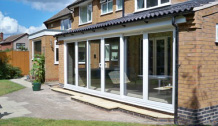FENSA Regulations

Double glazing has changed dramatically over the last 40 years since its first domestic manufacture to today. From the original double glazed sealed units of two sheets of float glass with a very small spacer bar to to-days high spec double glazed sealed units with toughen safety glass, wide spacer bars, argon-filled sealed units, Low-E glass, also self-cleaning glass which allows the double glazed unit to clean itself. This makes for a complete new hybrid double glazed sealed unit.
What is FENSA?
With effect from 1st April, 2002, all replacement double glazing window installations became subject to Document L of the Building Regulations. This states that new uPVC or timber double glazed windows should not have a U value higher than 2.0 W/m 2K and metal double glazed windows (aluminium) should not have a U value higher than 2.2 W/m 2K. With so much of it being installed in British homes, it has been agreed that the industry can adopt a 'self-assessment' method for administering the many thousands of installations that take place each week. The self-assessment scheme is referred to as FENSA - Fenestration Self Assessment Scheme. Providing that the company you are dealing with is registered with the FENSA scheme, they will certify that the work complies with the relevant regulations and you will not need to notify your local council.
If the glazing company is not a member of FENSA or you are carrying out the work yourself on a 'DIY' basis, then approval will have to be obtained from the local authority.
It is most important to conform to these new regulations as you will need to provide proof of compliance with Document L if you wish to sell your property after having installed replacement windows.
This window regulation particularly affects the minimum levels of insulation that replacement units must achieve when fitted in your home. Levels of insulation are measured as U values. The lower the U value, the better the level of insulation. What was previously referred to a 'normal' double glazing, i.e. two panes of glass separated by a spacer bar is very unlikely to conform to building regulations. To obtain the required level of insulation, it may be necessary to use low emissivity glass, Pilkington K for example, and argon gas filled sealed units.
Double glazing for the technical minded

What exactly is it? Today, it is the general term used for uPVC windows / replacement windows. The double glazing part of the window is the glass, or sealed unit.
This comprises of two panels of glass kept apart by a spacer bar which contains hundreds of tiny silica balls. These same balls can be found in little bags you find in packages when you buy electrical goods to keep then dry and free from moisture. It is these balls which soak up any moisture which exists in the air gap between the two panes of glass.
Float glass or safety toughened (tempered) glass?
Double glazed sealed units will either be normal float glass for small sealed units or toughen also known as tempered glass for larger units as required by Building Regulations and the Glass and Glazing Federation.
What is tempered or safety glass? Tempered glass when broken, shatters into many small fragments, which prevent major injuries. Due to these characteristics, tempered glass is used traditionally in applications requiring increased strength such as uPVC Patio doors, French doors and windows, which reduces the likelihood of injury in the event of breakages. However tempered glass should receive the same care as annealed glass.
The latest types offer greatly improved insulation (as required by FENSA) compared to older traditional units and single glazing. In addition, double glazed windows are also draught-proof, therefore reducing the amount of heat that can escape, so you can cut down on your heating and save on energy without sacrificing comfort.
Argon gas sealed units
Argon is a colourless, odorless, non-flammable, non-reactive, inert gas. Argon gas fills are used to reduce heat loss in double glazing sealed units by slowing down convection inside the air space. Argon gas is extremely cost-efficient, and works well with Low-e coated glazing.
When we talk about insulation glass without low-e coating, we refer to double glazing that uses air between panes as a primary source of insulation. As air itself is a good insulator, filling the gap between the glass panes with a low-conductivity gas such as argon improves window performance by reducing conductive and convective heat transfers. This is because gas is denser than air. Argon is the most commonly used fill gas, due to its excellent thermal performance and cost-efficiency in comparison to other gas fills.
Double glazed windows, patio doors, French doors, and uPVC doors now come under the requirements building regulations and document L. Now requires that all these products must meet a high standard of insulation.


